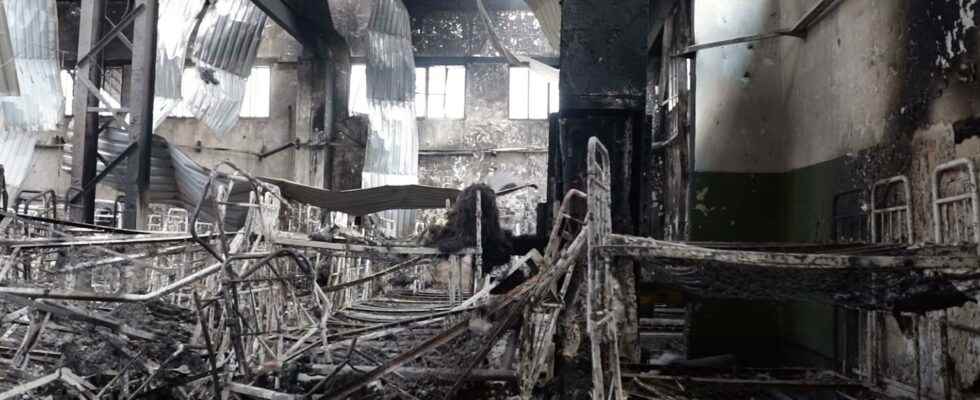Published: Less than 20 min ago
full screen
Next
Destroyed part of the prison in Oljonivka. Screenshot from video.
1 of 2 Photo: AP/TT
The prison building that was attacked in Oljonivka last week was newly built specifically to hold Azovstal soldiers, according to analysts.
There are many indications that the soldiers, who have been declared heroes in Ukraine, were moved there shortly before the attack, says Ukraine’s ambassador Andrii Plakhotniuk to TT.
– Everything was done on purpose.
The small community of Oljonivka was home to around 4,500 people in 2020. It was captured by Moscow-controlled separatists back in 2014, when Russia first attacked Ukraine. Today, the front line is only about 15 kilometers away.
The facilities attacked on July 29 are located in an industrial area, and were used as a prison for Ukrainian prisoners of war as early as 2014.
– We have had information about the nature and purpose of this facility for the past eight years, it has always been used to hold hostages and prisoners of war, says Andrii Plakhotniuk, Ukraine’s ambassador to Sweden.
According to the ambassador, the prisoners of war are regularly subjected to torture.
Seen as triumph
Many of the 53 soldiers killed in the attack had withstood the months-long siege of Mariupol and the Azovstal steelworks, where the city’s final battles took place. They have been declared heroes in Ukraine. Their capture was seen as a triumph for Russia, which showcased them on television.
– Some of our defenders were taken to Russia, to be subjected to interrogations that violate international conventions. Other POWs were moved to that specific location just before the attack. Everything was done on purpose, says Plakhotniuk.
The ambassador’s information sounds likely, according to Jakob Hedenskog, analyst at the Center for Eastern European Studies at the Foreign Policy Institute (UI).
The part of the prison facility that was hit the hardest in the attack seems to have been newly built with somewhat higher security in order to be able to hold Azovstal soldiers in particular there while waiting for the war to develop, he says.
– It has been assumed that Russia would hold mock trials against them. Now they have killed them instead, says Hedenskog.
A total of thousands of Ukrainians were taken to the facilities after the fall of Mariupol, writes the Washington Post. In March, about 30 volunteer workers who tried to help civilians leave Mariupol were captured, the newspaper writes. They were freed only a couple of weeks ago and testify to neglect, where 30 people could be crowded into a cell that was only built for six people. New prisoners were forced to undress and sit on their knees while guards beat them with batons, says one of them.
The freed volunteers confirm the picture that the attack seems to have hit a different building than the one where the prisoners were usually housed.
Denies inspection
The attacked premises, which according to Hedenskog seem to have been built up quickly, are still standing, albeit in a dilapidated state. However, it is seen as further evidence that Russia’s claim – that it was Ukraine that fired at it with Himars rockets – is not true.
– Then it wouldn’t stay, there would be a crater there. And Himars has a range of 80 kilometers. Why would Ukraine use them only 15 kilometers from the front? says Hedenskog.
Russia claims that the International Committee of the Red Cross (ICRC), which under the Geneva Convention has the right to inspect the treatment of prisoners of war, was invited to investigate the area. But according to the ICRC, no such invitation has come – and the organization has instead been denied access to the Russian-occupied lands.
– We demand that Russia let in the ICRC and the UN to conduct objective investigations into what really happened, says Andrii Plakhotniuk.
Facts
The attack on Oljonivka
On July 29, Russian officials and Russian-led separatists in occupied Donetsk said 53 prisoners of war were killed and another 75 wounded in an attack on a prison building in Oljonivka, located about two miles from the city of Donetsk in the region of the same name. They accused Ukraine of shelling the facility with the Himars rocket artillery system, which Ukraine received from the United States.
Ukraine quickly denied the allegations, saying it was in fact a Russian attack.
Since prisoners of war are protected under the Geneva Convention, the attack is considered a war crime.
The International Committee of the Red Cross (ICRC), which is mandated to inspect the treatment of prisoners of war under the Geneva Convention, has not been allowed to inspect the facility, which is in territory occupied by Russia since 2014, despite requests.
Read more
